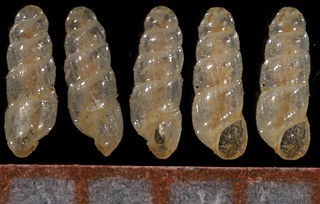Related Research Articles
Ultrasaurus is a genus of sauropod dinosaur discovered by Haang Mook Kim in South Korea. However, the name was first used unofficially in 1979 by Jim Jensen to describe a set of giant dinosaur bones he discovered in the United States. Because Kim published the name for his specimen before Jensen could do so officially, Jensen renamed his specimen Ultrasauros. Jensen's giant sauropod was later found to be a chimera, and the type remains are now assigned to Supersaurus.

In taxonomy, a nomen nudum is a designation which looks exactly like a scientific name of an organism, and may have originally been intended to be one, but it has not been published with an adequate description. This makes it a "bare" or "naked" name, which cannot be accepted as it stands. A largely equivalent but much less frequently used term is nomen tantum. Sometimes, "nomina nuda" is erroneously considered a synonym for the term "unavailable names". However, not all unavailable names are nomina nuda.

Chelodina, collectively known as snake-necked turtles, is a large and diverse genus of long-necked chelid turtles with a complicated nomenclatural history. Although in the past, Macrochelodina and Macrodiremys have been considered separate genera and prior to that all the same, they are now considered subgenera of the Chelodina, further Macrochelodina and Macrodiremys are now known to apply to the same species, hence Chelydera is used for the northern snake-necked turtles.
Palaeocursornis is a monotypic genus of pterosaurs. The only known species, P. corneti, was described in 1984 based on a single bone interpreted as the distal part of a left femur, found in Early Cretaceous (Berriasian rocks from a mine at Cornet near Oradea in northwestern Romania. It was initially assumed to be a flightless paleognathe bird, possibly a ratite, and later as a more primitive ornithuromorph or non-avialan theropod. However, re-evaluation of the specimen suggested that it was not a femur at all, but the upper arm bone of a pterodactyloid pterosaur similar to Azhdarcho.

Mesostigmata is an order of mites belonging to the Parasitiformes. They are by far the largest group of Parasitiformes, with over 8,000 species in 130 families. Mesostigmata includes parasitic as well as free-living and predatory forms. They can be recognized by the single pair of spiracles positioned laterally on the body.

Acicula is a genus of very small land snails with an operculum, terrestrial gastropod mollusks in the family Aciculidae.

Cochylimorpha is a genus of moths of the family Tortricidae.
Austrodinychus is a genus of mites in the family Nenteriidae.
Dobrogensisnenteria is a genus of mites in the family Nenteriidae.
Longitrichanenteria is a genus of mites in the family Nenteriidae.
Perstructuranenteria is a genus of mites in the family Nenteriidae.
Ruehmnenteria is a genus of mites in the family Nenteriidae.
Stammernenteria is a genus of mites in the family Nenteriidae.
Unguisnenteria is a genus of mites in the family Nenteriidae.
Ischaemum nativitatis, commonly known as the Christmas Island duck-beak, is a tropical grass in the family Poaceae. It is endemic to Christmas Island, an Australian territory in the north-eastern Indian Ocean. The specific epithet comes from the Latin nativitas ("birth") referring to the birth of Christ, or Christmas, after the name of the island.
The Kimberley death adder is a species of venomous snake in the family Elapidae native to northwestern Australia.

Pauropsalta is a genus of cicadas belonging to the family Cicadidae, first described in 1904 by Frederic Webster Goding and Walter Wilson Froggatt.
References
- ↑ Joel Hallan (ed.). "Nenteriidae Species Listing". Biology Catalog. Texas A&M University . Retrieved September 6, 2010.
- 1 2 3 "Family NENTERIIDAE Hirschmann, 1979 (nomen nudum)". Australian Faunal Directory. Australian Government. Retrieved 2024-09-19.
- ↑ Hirschmann, W. 1979. Stadiensystematik der Parasitiformes. Teil 1. Stadienfamilien und Stadiengattungen der Atrichopygidiina, erstellt im Vergleich zum Gangsystem Hirschmann 1979. Acarologie. Schriftenreihe für Vergleichende Milbenkunde26: 57-70